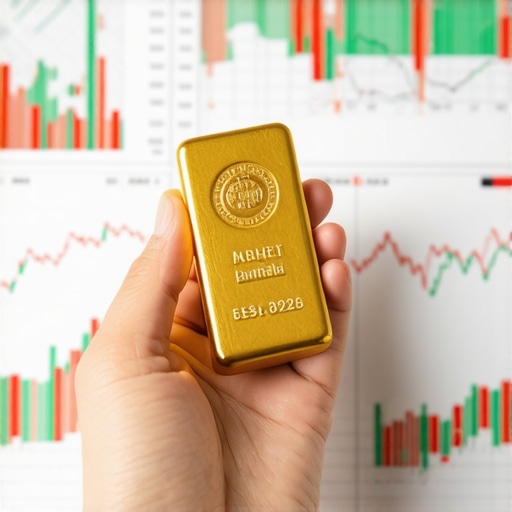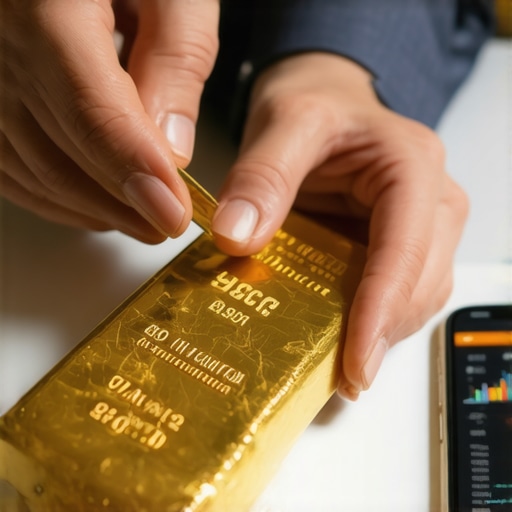Unlocking the Golden Gateway: Why Physical Gold Investment Matters in 2025
In a world fraught with economic uncertainty and fluctuating markets, physical gold remains a timeless refuge for investors seeking to preserve and grow their wealth. For beginners stepping into the gold investment arena in 2025, understanding how to navigate the complexities of safe physical gold investment is crucial. Unlike digital assets or paper gold, tangible gold offers a unique blend of liquidity, security, and historical value, making it a compelling choice for portfolio diversification.
Decoding Physical Gold: Coins, Bars, and Their Intrinsic Value
Physical gold investments primarily come in two forms: coins and bars. Each holds distinct advantages depending on the investor’s goals. Gold coins, such as the American Eagle or Canadian Maple Leaf, offer liquidity and collector appeal, often carrying premiums above spot price due to design and rarity. Bars, meanwhile, provide a cost-efficient method to accumulate substantial gold volume with minimal premium. Recognizing these nuances helps beginners tailor their investments to suit long-term wealth protection or short-term trade strategies. For a detailed comparison, explore the differences between gold coins and bars.
Practical Safety Measures: How to Secure Your Physical Gold Investment
Investing in physical gold demands not only purchasing but also safeguarding your assets. Storing gold securely—whether in certified vaults, bank safe deposit boxes, or insured home safes—is paramount to mitigate risks such as theft or damage. Additionally, proper documentation and authentication certificates ensure your gold’s legitimacy, a critical factor when reselling. Engaging with trusted dealers is essential; resources like how to identify trusted gold dealers offer practical guidance to avoid counterfeit pitfalls.
What Are the Most Reliable Strategies for Authenticating and Verifying Physical Gold?
Authentication techniques range from hallmark inspections and assay certificates to advanced methods like X-ray fluorescence (XRF) analysis. Beginners should familiarize themselves with reputable certification standards such as those from the London Bullion Market Association (LBMA). Working with dealers who provide transparent provenance and third-party verification not only secures your investment but also enhances resale value. Leveraging these expert-backed methods minimizes the risk of fraud and builds investor confidence.
Navigating Market Trends: Timing and Demand Dynamics in 2025
The gold market in 2025 is shaped by multifaceted factors including geopolitical tensions, inflationary pressures, and shifting global demand—especially from emerging markets in Asia. Understanding these supply-demand mechanics aids investors in making informed purchase timings. For instance, increased central bank gold acquisitions often signal bullish market conditions. Staying updated with gold demand trends and market analyses empowers investors to optimize entry points and hedge against volatility effectively.
Embark on Your Gold Journey with Confidence
Physical gold investment is not just about the metal itself but mastering a blend of knowledge, security, and market awareness. As you embark on this journey, consider sharing your insights or questions about safe gold investing in 2025 below. Your engagement enriches the community’s collective wisdom and helps beginners navigate this golden path wisely.
For further expert guidance on purchasing gold bars securely, visit our comprehensive guide on buying gold bars safely in 2025.
Authoritative insights referenced from the World Gold Council reinforce the enduring value and strategic benefits of physical gold investment (World Gold Council – Gold Demand Trends 2025).
Advanced Authentication Techniques: Beyond Basic Verification for Physical Gold
While hallmark inspections and assay certificates are foundational in verifying gold authenticity, investors in 2025 are increasingly leveraging technological advancements to ensure investment security. Methods such as X-ray fluorescence (XRF) analysis and ultrasonic testing provide non-destructive, precise assessments of gold purity and composition. These techniques, often employed by professional dealers and assay labs, minimize the risk of counterfeit and adulterated gold entering the market. For the discerning investor, understanding these tools enhances due diligence and builds confidence when engaging with both established and emerging dealers.
Moreover, blockchain-based provenance tracking is beginning to make inroads in the gold industry, allowing transparent and immutable recording of gold’s origin and transaction history. Such innovations align with the growing demand for ethical sourcing and traceability, especially important for investors concerned with responsible investment practices.
Interpreting Macroeconomic Indicators to Optimize Gold Purchase Timing
Gold’s price dynamics in 2025 are intricately linked to macroeconomic variables such as inflation rates, currency fluctuations, and geopolitical developments. Notably, inflation remains a critical driver, as rising consumer prices erode fiat currency value, prompting investors toward gold as a hedge. The gold price forecasts for 2026 suggest that inflationary pressures will continue to underpin demand, though volatility might increase in response to central bank policy shifts.
Currency strength, especially of the US dollar, inversely affects gold prices. A weakening dollar typically elevates gold demand globally, as gold becomes more affordable in other currencies. Geopolitical tensions—ranging from trade disputes to regional conflicts—also catalyze gold buying as a safe haven asset. By monitoring such indicators closely, investors can identify strategic entry points that balance risk and reward effectively.
How Can Emerging Technologies Revolutionize the Authentication and Trading of Physical Gold?
Emerging technologies such as blockchain, artificial intelligence (AI), and advanced spectroscopy are poised to transform the landscape of physical gold investment. Blockchain enables secure provenance tracking, reducing counterfeiting risks and fostering transparency. AI-powered analytics can predict market trends by processing vast datasets encompassing economic indicators, social sentiment, and geopolitical events. Additionally, portable spectrometers offer on-the-spot verification of gold purity, facilitating safe transactions outside traditional venues.
These advancements collectively empower investors with enhanced tools for authentication, pricing insights, and trading efficiency, potentially lowering entry barriers and increasing market participation. Keeping abreast of these technological trends is essential for investors aiming to maintain a competitive edge in the evolving gold market.
Industry experts at the World Gold Council emphasize the critical role of innovation in maintaining trust and stability within the gold ecosystem (World Gold Council – Gold Demand Trends 2025).
Incorporating Physical Gold into a Diversified Portfolio: Strategic Considerations
Physical gold serves as a cornerstone in portfolio diversification strategies, especially during periods of market uncertainty. Its low correlation with equities and bonds provides a buffer against systemic risks. Investors should consider allocation percentages carefully, balancing between physical gold holdings and other asset classes based on risk tolerance and investment horizon.
For those seeking diversified exposure without the challenges of physical storage, gold ETFs or mutual funds offer alternative avenues. However, physical gold ownership remains unmatched in control and tangibility. Detailed guidance on selecting suitable gold ETFs and mutual funds can be found in our article on gold ETFs vs mutual funds.
Engage with our community by sharing your experience or questions about integrating physical gold into your investment portfolio in 2025. Your insights contribute to a richer dialogue that benefits both novice and seasoned investors alike.
Decoding Complex Tax Implications for Physical Gold Investors in 2025
Investing in physical gold is not only about acquisition and security; it also necessitates a thorough understanding of the intricate tax landscape governing precious metals. In 2025, tax regulations surrounding gold investments vary significantly across jurisdictions, often influencing the net returns and strategic planning of investors.
For example, in the United States, physical gold is classified as a collectible under IRS rules, subject to a capital gains tax rate of up to 28% if held over a year, which is higher than the standard long-term capital gains rates for other assets. Additionally, reporting requirements for large transactions, including Form 1099-B disclosures by dealers, impose compliance responsibilities. Investors must also consider state-level taxes which can differ widely.
In contrast, some countries provide VAT exemptions for investment-grade gold, while others levy import duties or specific sales taxes, affecting the effective cost basis. Staying updated with local taxation policies and consulting with tax professionals ensures that investors optimize their tax position and avoid costly penalties.
How Can Investors Navigate Cross-Border Taxation Challenges When Trading Physical Gold?
Cross-border transactions introduce further complexity, particularly for investors purchasing gold internationally or transferring holdings across borders. Issues such as double taxation, customs declarations, and differing definitions of investment-grade gold require careful legal and financial scrutiny.
Utilizing tax treaties, leveraging legal frameworks for tax credits, and maintaining meticulous records of provenance and transaction history become indispensable. Collaborating with specialized tax advisors who understand both source and destination country regulations is critical for mitigating risks and ensuring compliance.
Ethical Sourcing and Sustainability: The New Frontier in Responsible Gold Investment
Modern investors increasingly prioritize ethical considerations alongside financial returns. The gold industry’s legacy of environmental degradation and human rights concerns has catalyzed demand for transparency and sustainability in sourcing.
Certification schemes such as the Responsible Jewellery Council (RJC) and the Fairmined Standard provide frameworks to assure that gold is mined under rigorous environmental and social criteria. Investing in gold that carries such certifications not only aligns with ethical principles but also mitigates reputational risks and enhances long-term value.
Furthermore, blockchain-enabled provenance tracking, as previously discussed, facilitates immutable records of ethical sourcing, enabling investors to verify origin and production conditions with unprecedented certainty.
Strategic Diversification: Integrating Physical Gold with Alternative Precious Metals and Digital Assets
While physical gold remains a stalwart in hedging against macroeconomic uncertainties, sophisticated investors in 2025 are exploring diversified precious metal portfolios that include silver, platinum, and palladium. Each metal carries unique market drivers and volatility profiles, offering nuanced risk-return characteristics.
Simultaneously, the rise of tokenized gold and blockchain-backed digital assets presents novel investment avenues that combine the tangibility of physical metals with the liquidity and accessibility of digital markets. However, these emerging instruments require rigorous due diligence regarding custody, regulatory frameworks, and counterparty risks.
Balancing allocations among physical gold, other precious metals, and digital tokens can optimize portfolio resilience and capitalize on diverse market trends.
For an in-depth exploration of precious metals portfolio construction, consult our expert guide on Precious Metals Diversification Strategies for 2025.
Advanced Security Protocols: Beyond Traditional Safeguarding of Physical Gold Assets
As gold investment sophistication grows, so does the necessity for advanced security measures. Beyond conventional safe deposit boxes and insured home vaults, investors are increasingly employing biometric access controls, geofencing technologies, and AI-driven surveillance systems to protect their holdings.
Moreover, custodial services now offer insured vaulting with multi-layered physical and cyber security, catering to high-net-worth individuals seeking turnkey solutions. Integrating these technologies reduces vulnerability to theft, fraud, and loss.
Exploring these next-generation security solutions enables investors to maintain peace of mind and ensures asset integrity in an increasingly complex risk environment.
Authoritative insights on these evolving security trends have been detailed by the Secure Storage Alliance, highlighting best practices and innovation adoption.
Harnessing AI and Blockchain: The Vanguard of Gold Authentication and Trading
In an era where technological disruption redefines asset management, physical gold investment is no exception. The integration of artificial intelligence (AI) and blockchain technology is revolutionizing the authentication processes and trading frameworks, offering unprecedented transparency and security. AI algorithms analyze multifaceted data streams—including economic indicators, geopolitical events, and social sentiment—to forecast market movements with enhanced precision. Concurrently, blockchain’s immutable ledger provides a tamper-proof provenance trail, assuring investors of gold’s ethical origin and authenticity. These advancements not only mitigate traditional risks such as counterfeiting and fraud but also streamline transactional efficiency, empowering investors to make data-driven decisions in real time.
Decoding Regulatory Complexities: Navigating International Gold Taxation Frameworks
As the globalization of gold investment accelerates, understanding regulatory landscapes becomes critically important. Jurisdictional disparities in capital gains taxation, VAT applicability, and reporting obligations can materially affect investment outcomes. For instance, European Union member states exhibit varied VAT treatments for investment-grade gold, complicating cross-border acquisitions. Furthermore, anti-money laundering (AML) directives impose stringent due diligence requirements on dealers and custodians. Investors must therefore engage with specialized legal counsel and tax advisors to tailor strategies that optimize tax efficiency while ensuring full compliance. The OECD Tax Database offers comprehensive insights into international tax regulations, serving as a pivotal resource for informed decision-making.
What Are the Best Practices for Integrating Physical Gold into a Multi-Asset Portfolio Amid Market Volatility?
Integrating physical gold into a diversified portfolio demands a nuanced approach that balances risk mitigation with liquidity considerations. Experts recommend allocating approximately 5-15% of total assets to physical gold, calibrated to individual risk tolerance and investment horizons. Gold’s historically low correlation with equities and bonds enhances portfolio resilience during downturns. Incorporating gold bars and coins with varying liquidity profiles further optimizes flexibility. Additionally, coupling physical holdings with derivatives or gold-backed digital assets can provide dynamic exposure without compromising safety. Continual portfolio rebalancing in response to macroeconomic shifts ensures alignment with strategic objectives.
Embracing Sustainability: Ethical Gold Investment as a Differentiator in 2025
Investor consciousness has shifted markedly toward sustainable and responsible investment practices. Ethical gold sourcing is no longer ancillary but a core investment criterion. Certifications such as those from the Responsible Jewellery Council (RJC) and Fairmined Standard exemplify rigorous environmental stewardship and social responsibility. Blockchain-enabled supply chain transparency complements these certifications by providing verifiable data on mining practices and labor conditions. Embracing these standards not only mitigates reputational risks but also aligns investment portfolios with global ESG mandates, enhancing appeal to institutional investors and conscientious individuals alike.
Advanced Security Ecosystems: Fortifying Physical Gold Holdings in the Digital Age
Protection of physical gold assets now transcends traditional methodologies. State-of-the-art security ecosystems incorporate biometric authentication, AI-powered threat detection, and geofencing controls to preempt unauthorized access. Custodial services have evolved to offer insured, multi-layered security vaults with integrated cyber defenses, catering to high-net-worth clients. These solutions provide real-time monitoring and rapid incident response, drastically reducing vulnerability to sophisticated theft attempts. Adopting such advanced protocols ensures asset integrity and investor peace of mind in an increasingly complex risk landscape.
Authoritative insights on these innovations are extensively documented by the Secure Storage Alliance, the leading consortium advocating best practices in asset protection.
Amplify Your Gold Investment Expertise Today
Staying ahead in the nuanced arena of physical gold investment necessitates continuous learning and strategic adaptation. Engage with our expert resources and community forums to deepen your understanding of cutting-edge authentication technologies, regulatory navigation, and portfolio integration techniques. Harness these advanced insights to secure your wealth and capitalize on gold’s enduring value in 2025 and beyond.
Frequently Asked Questions (FAQ)
What distinguishes physical gold coins from gold bars in terms of investment advantages?
Gold coins typically offer higher liquidity and collectible value due to their design and rarity, often carrying premiums above spot price. Gold bars, conversely, provide a more cost-efficient means to accumulate large quantities of gold with lower premiums, making them ideal for bulk investment and long-term wealth preservation.
How can I ensure the authenticity of physical gold before purchase?
Authentication involves examining hallmarks, verifying assay certificates, and utilizing advanced techniques like X-ray fluorescence (XRF) analysis. Engaging with reputable dealers who provide transparent provenance and third-party verification minimizes counterfeit risks. Emerging technologies such as blockchain provenance tracking further enhance accountability.
What are the best practices for securely storing physical gold assets?
Secure storage options include certified vaults, insured bank safe deposit boxes, and heavy-duty home safes with advanced security features like biometric locks. High-net-worth investors may opt for custodial services offering multi-layered physical and cyber security, AI surveillance, and real-time monitoring to mitigate theft and loss risks.
How do macroeconomic factors influence the optimal timing for purchasing physical gold?
Key factors include inflation rates, US dollar strength, geopolitical tensions, and central bank policies. Rising inflation and geopolitical instability typically increase gold demand, while a weaker dollar makes gold more affordable globally. Monitoring these indicators helps investors identify strategic entry points to optimize returns.
What tax considerations should physical gold investors be aware of in 2025?
Tax regulations vary widely by jurisdiction. In the U.S., physical gold is taxed as a collectible with capital gains rates up to 28%. Some countries offer VAT exemptions on investment-grade gold, while others impose import duties or sales taxes. Cross-border transactions require attention to double taxation treaties and customs declarations. Consulting tax professionals is essential for compliance and optimization.
Can emerging technologies like AI and blockchain truly transform gold authentication and trading?
Yes. Blockchain provides immutable provenance records ensuring ethical sourcing and authenticity, while AI analyzes vast datasets to forecast market trends. Portable spectrometers enable real-time purity verification. These technologies collectively increase transparency, reduce fraud, and enhance trading efficiency.
How should physical gold be integrated into a diversified investment portfolio?
Experts recommend allocating between 5% and 15% of total assets to physical gold to balance risk and liquidity. Combining gold bars and coins with different liquidity profiles and complementing holdings with gold-backed digital assets or derivatives can optimize diversification and resilience during market volatility.
What role does ethical sourcing play in gold investment today?
Ethical sourcing is increasingly vital, with certifications like the Responsible Jewellery Council (RJC) and Fairmined Standard ensuring environmentally responsible and socially equitable mining practices. Blockchain-enabled supply chains further enhance transparency, mitigating reputational risks and aligning investments with ESG mandates.
Are there advanced security technologies recommended for protecting physical gold?
Yes. Beyond traditional safes, investors use biometric authentication, AI-powered surveillance, geofencing, and insured custodial vaults with cyber defenses. These multi-layered security ecosystems provide robust protection against sophisticated theft and fraud attempts.
What challenges arise in cross-border gold investment and how can they be managed?
Challenges include differing tax regimes, customs regulations, and compliance with anti-money laundering laws. Investors should maintain meticulous transaction records, use tax treaties to avoid double taxation, and consult specialized advisors familiar with the legal frameworks of involved countries.
Trusted External Sources
- World Gold Council: Provides comprehensive data and analyses on global gold demand trends, market dynamics, and innovations in authentication and sustainability, essential for informed investment decisions.
- Responsible Jewellery Council (RJC): Offers rigorous certification standards ensuring ethical mining and sourcing, critical for investors prioritizing sustainability and social responsibility.
- Secure Storage Alliance: An authoritative consortium detailing best practices and emerging technologies in physical asset protection, including advanced security protocols for gold storage.
- Organisation for Economic Co-operation and Development (OECD) Tax Database: A vital resource offering detailed insights into international tax regulations, helping investors navigate complex cross-border tax frameworks.
- Fairmined Standard: Establishes strict criteria for responsible gold mining, supporting investors seeking verified ethical investment options aligned with global ESG principles.
Conclusion
Physical gold investment in 2025 remains a robust strategy to safeguard wealth amid economic uncertainties, offering tangible security, portfolio diversification, and inflation hedging. Mastery of authentication techniques, secure storage solutions, and a nuanced understanding of macroeconomic and regulatory landscapes are indispensable for success. Embracing emerging technologies such as AI and blockchain enhances transparency and efficiency, while ethical sourcing elevates investment integrity and long-term value. By integrating physical gold thoughtfully within diversified portfolios and adhering to advanced security and tax compliance practices, investors position themselves advantageously in a complex market environment.
We invite you to deepen your expertise by sharing your experiences or questions, exploring our expert resources, and applying these strategic insights to your gold investment journey in 2025 and beyond.










